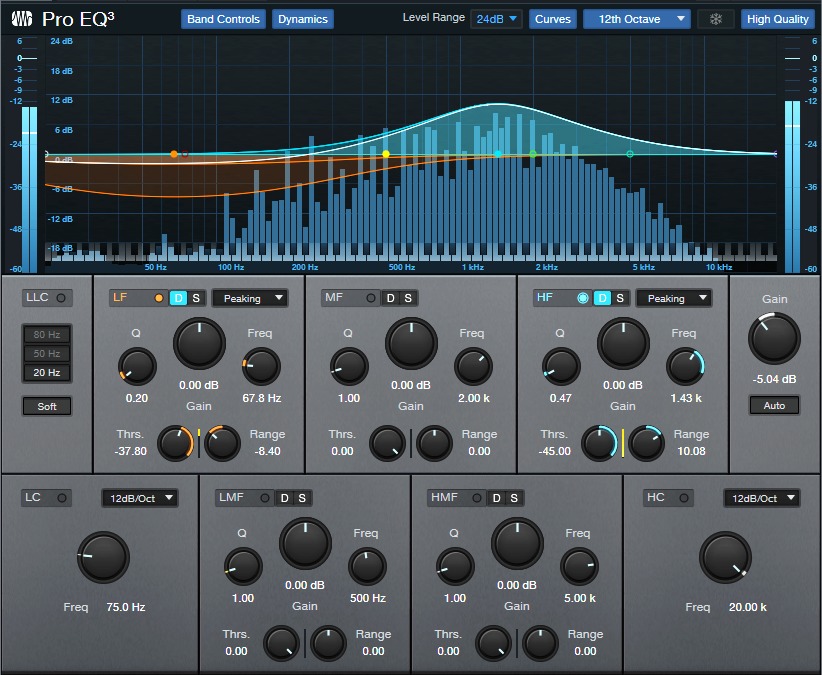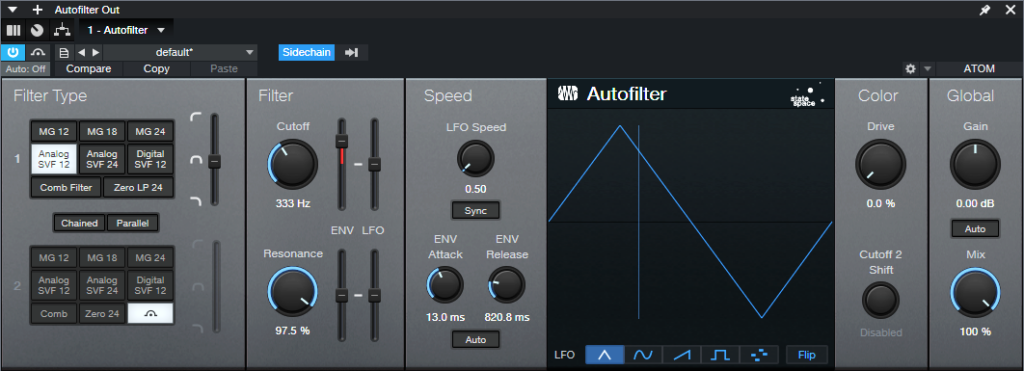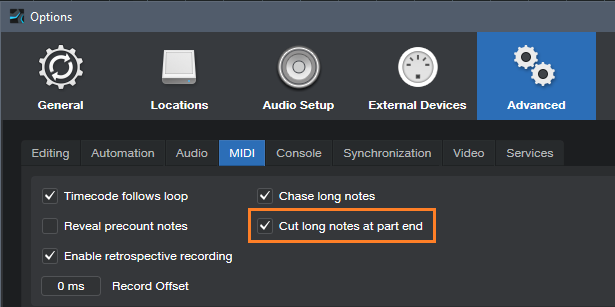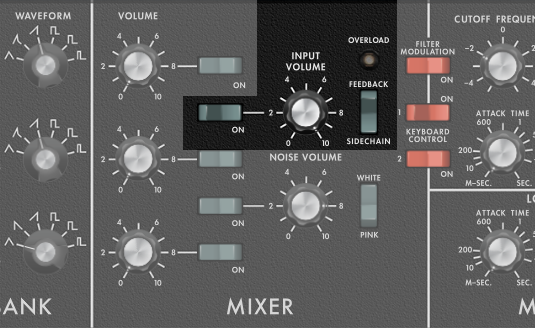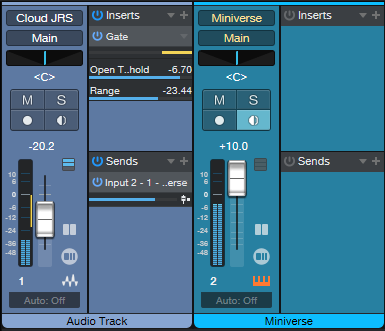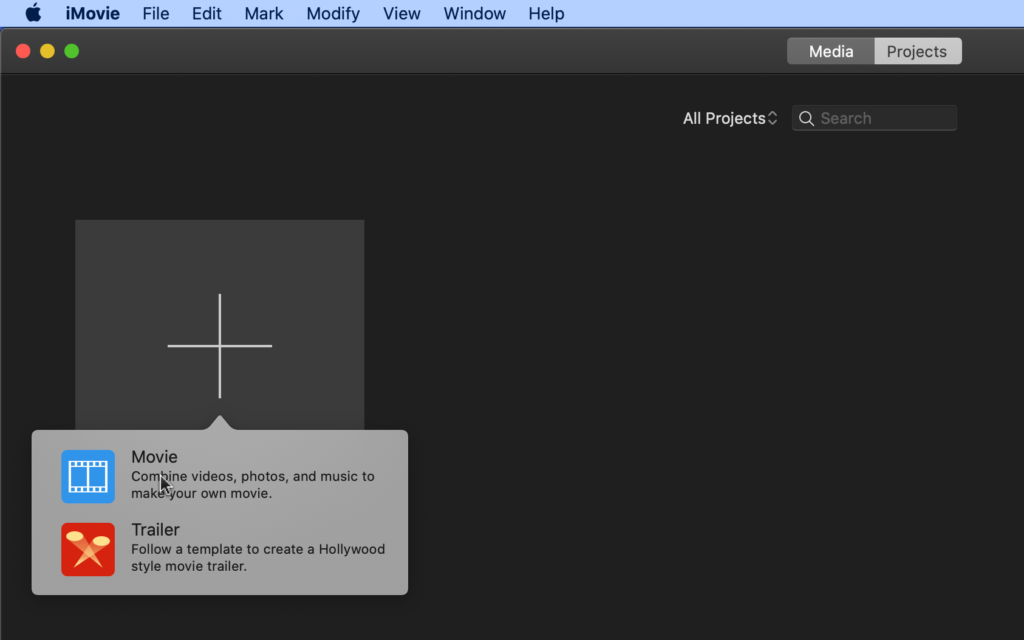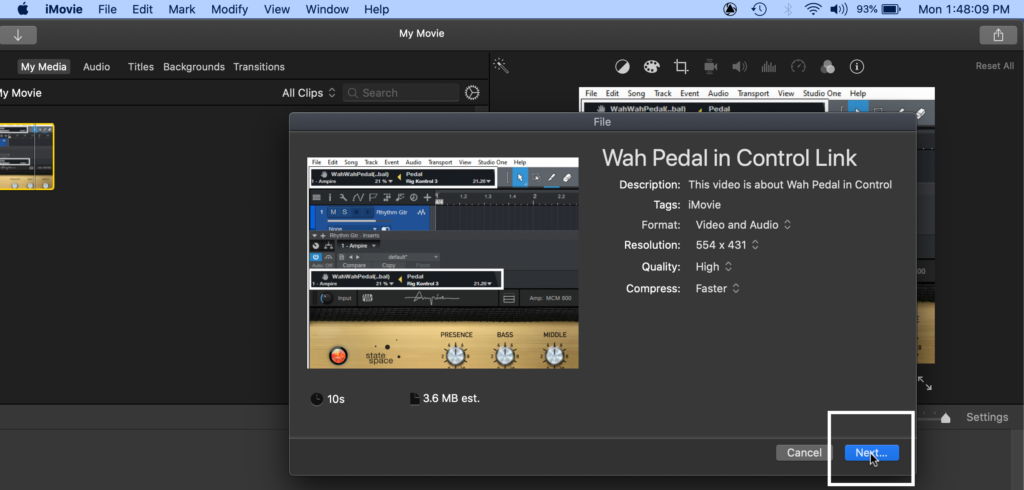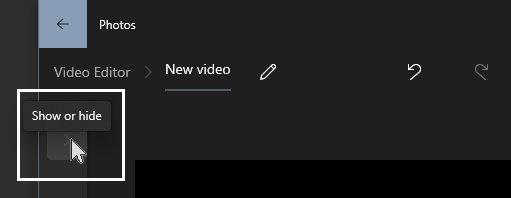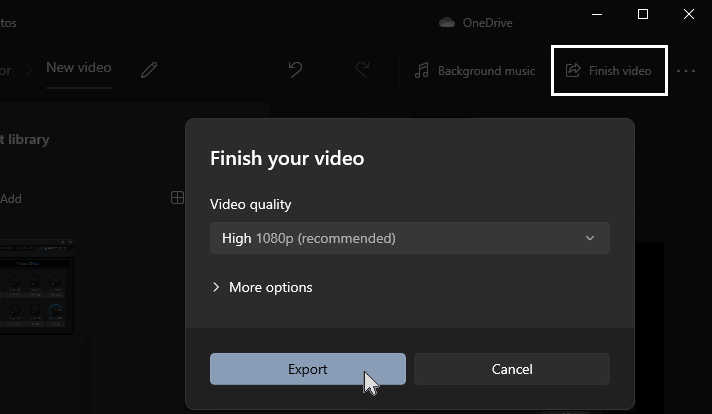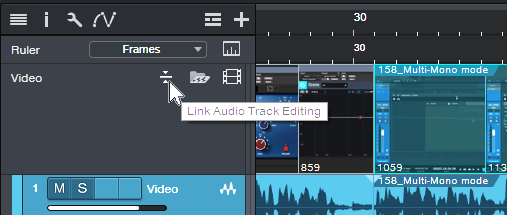Category Archives: Studio One
Better Autofilter Control

The March 2020 blog post, Taming the Wild Autofilter, never appeared in any of The Huge Book of Studio One Tips & Tricks eBook updates. This is because the tip worked in Studio One 4, but not in Studio One 5. However, Studio One 6 has brought the Autofilter back to its former glory (and then some). Even better, we can now take advantage of FX Bus sends and dynamic EQ. So, this tip is a complete redo of the original blog post. (Compared to a similar tip in eBook version 1.4, this version replaces the Channel Strip with the Pro EQ3 for additional flexibility.)
The reason for coming up with this technique was that although I’d used the Autofilter for various applications, I couldn’t get it to work quite right for its intended application with guitar or bass. Covering the right filter cutoff range was a problem—for example, it wouldn’t go high enough if I hit the strings hard, but if I compensated for that by turning up the filter cutoff, then the cutoff wouldn’t go low enough with softer picking. Furthermore, the responsiveness varied dramatically, depending on whether I was playing high on the neck, or hitting low notes on the low E and A strings. This tip solves these issues.
The guitar track’s audio uses pre-fader sends to go to two FX Buses (fig. 1). The Autofilter Out FX Bus produces the audio output. The Autofilter Trig FX bus processes the audio going to the Autofilter’s sidechain. By processing the Guitar track’s send to the sidechain, we can make the Autofilter respond however we want. Furthermore, if needed, you can feed a low-level signal from the Guitar track’s pre-fader send into the Autofilter, to avoid distortion with high-resonance settings. This is possible because the Autofilter Trig bus—which you don’t need to hear, and can be any level you want—controls the Autofilter’s action.
Perhaps best of all, this also means the Autofilter no longer depends on having an input signal with varying dynamics. You can insert an amp sim, overdrive, compressor, or anything else that restricts dynamic range in front of the Autofilter. The Autofilter will still respond to the original Guitar track’s dynamics, as processed by the dynamic EQ.
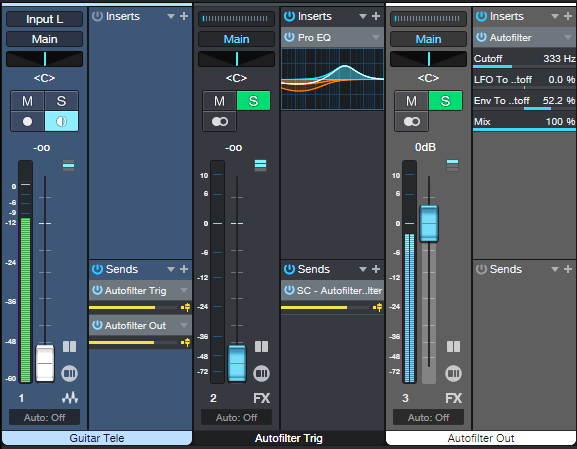
The Pro EQ3 (fig. 2) conditions the send to make the Autofilter happy. The dynamic EQ attenuates lower frequencies that exceed the Threshold, but amplifies higher frequencies that exceed the Threshold. So, the Autofilter’s response to the higher-output, lower strings can be consistent with the upper strings.
The Autofilter (fig. 3) sets the LFO Cutoff Modulation to 0, because I wanted only the envelope to affect the filter. The settings for the Autofilter and Pro EQ3 interact with each other, as well as with the guitar and pickups. In this case, I used a Telecaster with a single-coil treble pickup. For humbucking pickups, you may need to attenuate the low frequencies more.
Like Autofilters in general, it takes some experimenting to dial in the ideal settings for your playing style, strings, pickups, musical genre, and so on. However, the big advantage of this approach is that once you find the ideal settings, the response will be less critical, more consistent, and more forgiving of big dynamic changes in your playing.
And here’s a final tip: Processing the signal going to the Autofilter’s sidechain has much potential. Try using Analog Delay, X-Trem, and other effects. Also, although the original Guitar track and Autofilter Trig faders are shown at 0, no law says they have to be. Feel free to mix in some of the original guitar sound, and/or the equalized Autofilter Trig bus audio.
Lead Guitar Editing Hack
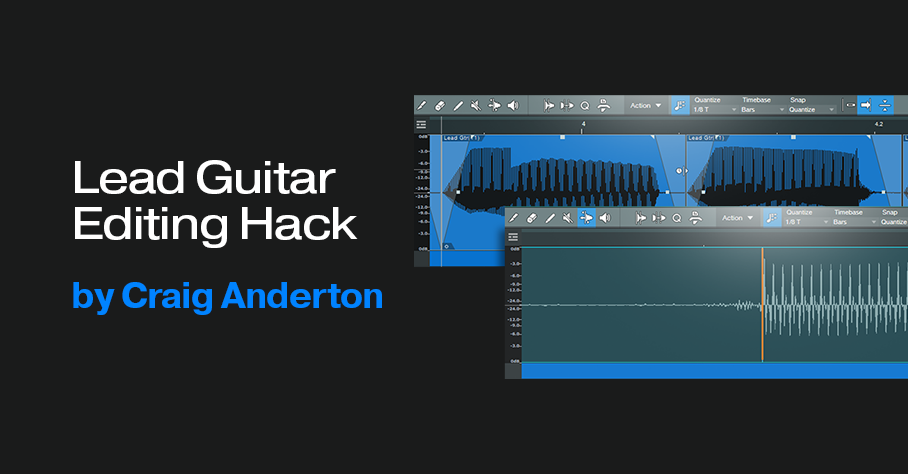
High-gain distortion is great for lead guitar sustain and tone, but it also brings up that “splat” of pick noise at the note’s beginning. Sometimes, you want the gritty, dirty feel it adds. But it can be a distraction when your goal is a gentler, more lyrical tone that still retains the sound of heavy distortion.
This technique gives the best of both worlds for single-note leads, and is particularly effective with full mixes where the lead guitar has a lot of echo. Normally the echo will repeat the pick noise, so reducing it reduces clutter, and gives more clarity to the mix.
1. Open the lead part in the Edit window.
2. Choose Action, and under the Audio Bend tab, select Detect Transients.
3. Zoom in to verify there’s a Bend Marker at the beginning of each note’s first peak (fig. 1). If you need to add a Bend Marker, click at the note’s beginning using the Bend tool. To move a Bend Marker for more precise placement, hold Alt/Opt while clicking on the marker with the Bend tool, and drag.

4. Choose Action, and under the Audio Bend tab, select Split at Bend Markers. Now, each note is its own Event (fig. 2).
5. Make sure all the notes are selected (fig. 3). The next steps show any needed edits being made to one Event. However, because all the notes are selected, any edit affects all notes equally. To show the edits in more detail, the following steps zoom in on two notes.
6. Trim the note ends to remove some of the pre-note “dirt” (fig. 4).
7. Add a fade-in and fade-out (fig. 5). This doesn’t have to be exact, because you’ll optimize the times in step 9.

8. There’s a gap between notes, so time-stretch the end of the note to cover the gap. Alt/Opt+click on the end of a note, and drag to the right until the note end is up against the beginning of the next note (fig. 6).

9. That may seem like a lot of work, but once you’ve defined the bend markers, having to edit only one note to edit all the notes speeds the process.
Start playback with all the notes still selected, listen, and vary the fade times. Also experiment with the curve shape. A concave curve can work well with attacks. I often try for the minimum amount of attack and decay that gives the desired result, but not always—when taken to extremes, being able to shape notes enables options that sound almost like a synthesizer.
The audio example shows how this tweak affects a single-note lead. The first part is as recorded, the second part uses this tip.
Useful Features I Totally Missed
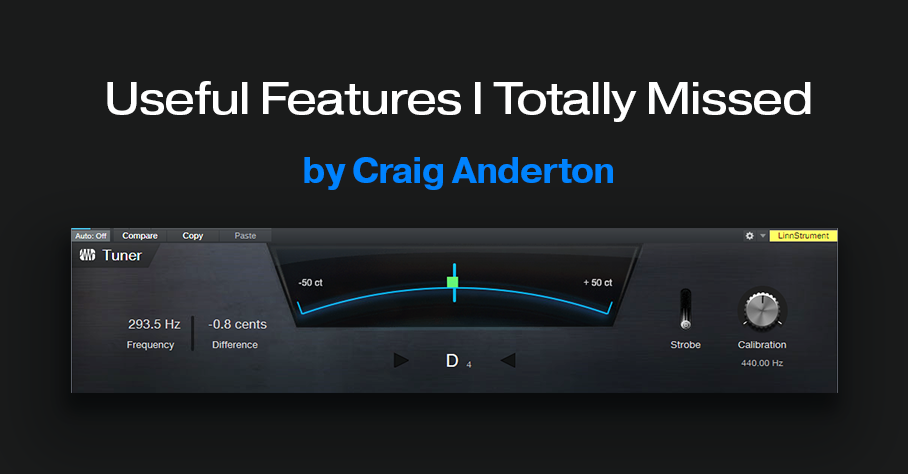
First, an announcement: version 1.4 of The Huge Book of Studio One Tips and Tricks is a free update to owners of previous versions. It’s currently available from Sweetwater, and will soon be in the PreSonus shop. Revised to bring it up to date with Studio One 6, this is the most comprehensive update yet, and has over 250 tips. It’s also available to new buyers for $19.95.
Okay, on to the blog post, and let me start by admitting…I’m a little slow sometimes. So now that I’ve admitted it, you don’t need to add comments like “Seriously? You just figured this stuff out? Dude, what’s wrong with you?” But maybe you didn’t know about at least some of these features either, so I hope you find this useful.
Insert the Tuner in Your Master Bus
Solo the channel you want to tune, and when the tuner (fig. 1) is in the master bus, it’s always available. If there are effects that mess up the tuning (chorus, delay, etc.), turn off the associated Insert rack before tuning.
Colorize Plug-In Headers to Match Channel Colors
Colorizing plug-ins helps when you have several of the same type of processor open. The header color matches the track color. So, if your vocal track is blue and your bass track green, you’ll know the plug-in with the blue header affects the vocal track. To colorize, select the Mix view, and click on the Wrench. Under Visibility, click on Colorize Plug-In Header.
Offset an Automation Envelope Easily
Suppose your automation moves are perfect, but the track’s level needs to be offset up or down. You can’t just move the fader, because it’s following the automation. So, you change the automation envelope. Then you realize you need to make another change in the track, so you go back to the track, zoom in, and adjust the envelope again. Or you insert a VCA channel to change the track gain, while keeping the envelope the same. But it’s simplest just to tweak the output level of a processor in the track (like the Pro EQ3’s Gain control). If there isn’t one, insert a Mixtool. Now you can tweak the level offset quickly and easily. [Cue Homer Simpson saying “Doh!”]
Cut Long Notes at Part End
The world of Studio One > Options > Advanced [Windows] or Studio One > Preferences [Mac] is well worth exploring. Working with MIDI drove me crazy until I understood what this check box did (fig. 2).
Under the MIDI tab, Cut Long Notes at Part End defaults to being unchecked. This means if you cut a part in the middle of a long note, the section of the note past the cut will continue to play—even though you won’t see it in the part past the cut. This led me to a lot of “where’s that MIDI note coming from?” Checking this option adds a Note Off at the cut, so the note stops playing at the end of the part. But if you want to get it back, no problem. Slip-edit the end of the part back out, and the note will still be there.
Show Channel Notes
Under Song Information, you can enter Track Notes for the tracks—I use that feature all the time. But you can also open up a space at the bottom of a channel to see Channel Notes, and one day I realized that Channel Note and Track Note are the same thing. Eureka! I didn’t have to open the Song Info or Inspector to see the Track notes. You’ll find the check box to show the Channel Notes, aka Track Notes, under Channel Components in the Mixer view’s wrench options (fig. 3).
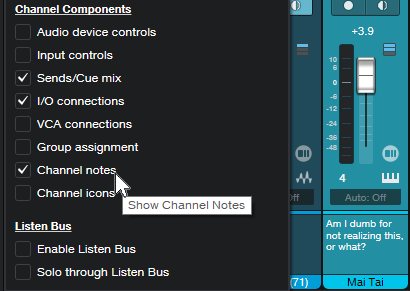
Horizontal Scrolling in Edit View
You can scroll horizontally in Edit view by holding Shift and rotating the mouse wheel. I often zoom way in with the Edit view to find little glitches, and this shortcut makes the process easier.
Tab Through Parameters in the Pro EQ3
Click on one of the parameter value labels. Tab to go to the next parameter, or Shift+tab to return to the previous one. This includes the Threshold and Range parameters in the new Dynamics control section. After reaching the last parameter in an EQ stage, hit tab several times to move to the next stage.
Move the Send Rack Vertically in a Channel
There are three ways to move the Send rack vertically in a channel:
- Click on the Splitter bar above the Sends, and drag up and down to move all the Sends together, regardless of where they are vertically.
- Shift-Click on the Splitter bar, and you can move just that Send rack up or down.
- Ctrl/Cmd click on the Splitter bar, and they all jump to the same vertical position.
EZ FX Channel
Drag an effect into the space below a Channel’s Send, and it automatically creates an FX Channel with that effect. Has this always been there and I didn’t know it? Was it added recently? Did I just forget about it? I don’t know, but it’s particularly relevant now that Version 6 FX Buses have Sends.
Insert the Free VU Meter in Your Master Bus
As described in detail in a previous blog post, you can download a free VU meter plug-in (or at least you can until someone at PreSonus realizes it’s really cool, and decides to charge for it). Try it, and you’ll see why I like it—the average reading gives a different perspective on your audio. Also, the clip indicator blinks instead of staying on, so it’s easy to see where peaks are causing problems. You can even check correlation, and set a scale for reference levels. Go ahead, insert it—you can thank me later.
So, what other really great features that “everyone knows about” am I missing? Your comments are welcome!
How to Use Virtual Synths as Signal Processors
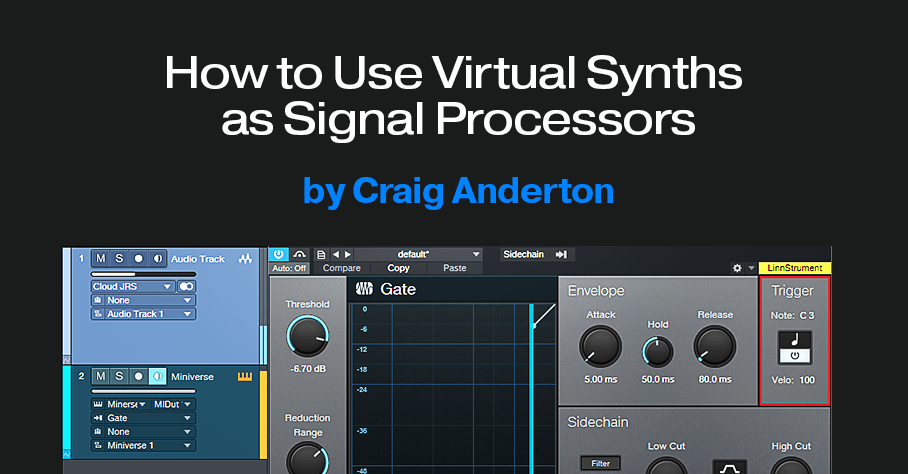
Some virtual instruments can accept external audio inputs. This lets you process audio through the synthesizer’s various modules like filters, VCAs, effects, and so on. Essentially, the synthesizer becomes an effects processor. To accommodate this, Version 6 introduced a sidechain audio input for virtual instruments.
Not all instruments have this capability. I’ve tested the audio sidechain input successfully with Cherry Audio’s CA2600, Miniverse, PS-30, Rackmode Vocoder, and Voltage Modular. Arturia’s Vocoder V also works. I’d really appreciate any notes in the Comments section about other instruments that work with this feature.
Is My Virtual Instrument Compatible?
Insert the synth, and click on the sidechain symbol in its header. If you see a box with Send and Output options (fig. 1), you can feed audio into the synthesizer. Check the box for either a Send from a track (pre- or post-fader), or the track output.
You’ll probably need to enable the virtual instrument’s external audio input. Fig. 2 shows how to do this with Cherry Audio’s Miniverse, which emulates how the Minimoog accepted external inputs:
- Set the Input’s Mixer switch to on.
- Turn up the Input volume.
- The Miniverse can feed the external input from its own output to obtain feedback, or from the Sidechain. For this application, choose Sidechain.
Studio One Setup
Fig. 3 shows the track layout for Studio One. Ignore the Gate for now, we’ll cover that shortly.
I chose a post-fader Send from the audio track, not the track output, to drive the synth. This is because I wanted to be able to mix parallel tracks—the audio providing the input, and the audio processed by the synthesizer.
Using the Gate
You won’t hear anything from the synth unless you trigger the VCA to let the external audio signal through. You can play a keyboard to trigger the synth for specific sections of the audio track, but the Gate can provide automatic triggering (fig. 4).
With Triggering enabled, the Gate produces a MIDI note trigger every time it opens. So, Insert the Gate in the audio track, and set the Instrument track’s MIDI input to Gate. Now, the audio will trigger the synth. Adjust the Gate Threshold for the most reliable triggering. This is particularly useful with instruments that have attacks, like drums, guitar, piano, etc.
Import JPG/PNG Files into the Video Track
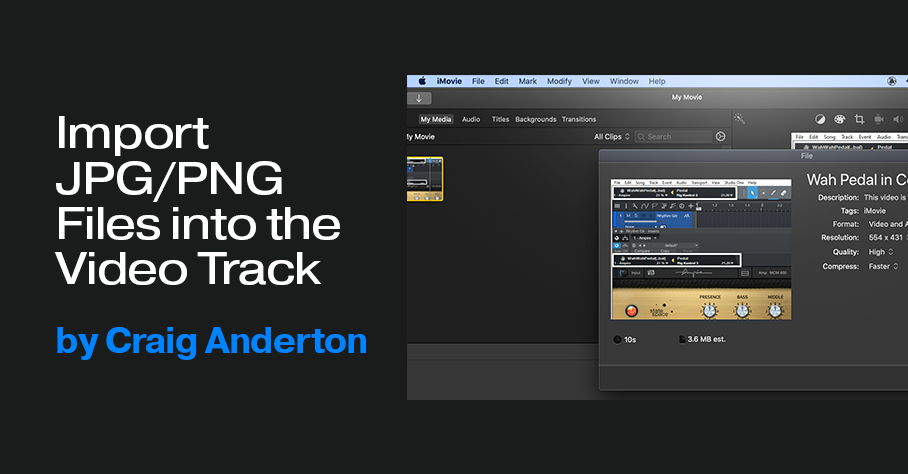
This builds on last week’s tip about splitting and navigating within the Video Track, because one of the main reasons for creating splits is to import additional material. Although the Video Track can accept common video file formats, sometimes you’ll need to import static JPG or PNG images. These could be a band logo, screen shots for a tutorial video, a slide with your web site and contact information, photos from a smartphone, public domain images, etc. To bring them into the video track, you need to convert them into a compatible format, like MP4.
Many online sites offer to “convert JPEG to MP4 for free!” However, I’m skeptical of those kinds of sites. Fortunately, modern Mac and Windows operating systems include tools that can do any needed conversion.
Converting with the Mac
1. Open iMovie, click on Create New, and then choose Movie.
2. Click on Import Media. Navigate to the location of the image you want to convert, and open it in iMovie.
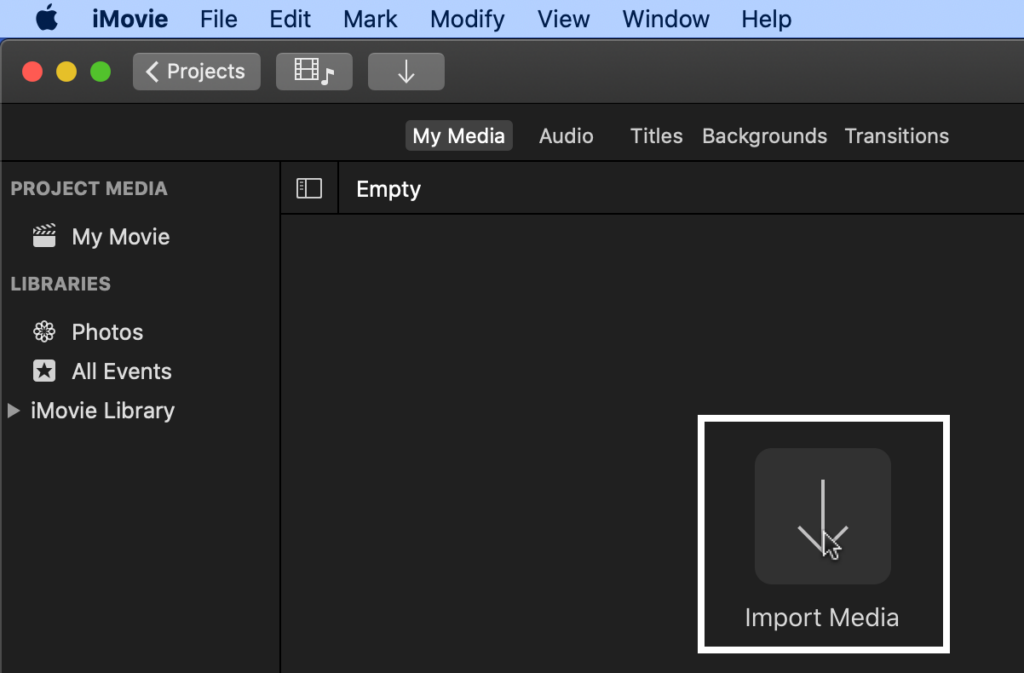
3. Choose File > Share > File.
4. In the window that opens, click Next…
5. Navigate to where you want to save the file, and click on Save. You now have an MP4 file.
If you need a longer video than the default 3 seconds, drag more copies of the file to the timeline before saving. Or, drag the file into Studio One multiple times.
Converting with Windows
1. Open Video Editor (it’s not necessary to install Clipchamp). Click on New Video, and name it.
2. Click on the nearly invisible Project Library button.
3. Drag the image you want to convert into the Library. Then right-click on the image, and choose Place in Storyboard. The default length is 3 seconds. If it needs to be longer, select Place in Storyboard again. Or, drag the finished file into Studio One multiple times.
4. Click on Finish video (in the upper right), then click on Export.
5. Name the file, navigate to where you want to save it, then click on Export. Done! Your image is now an MP4 video you can insert into Studio One.
Basic Video Editing in Studio One
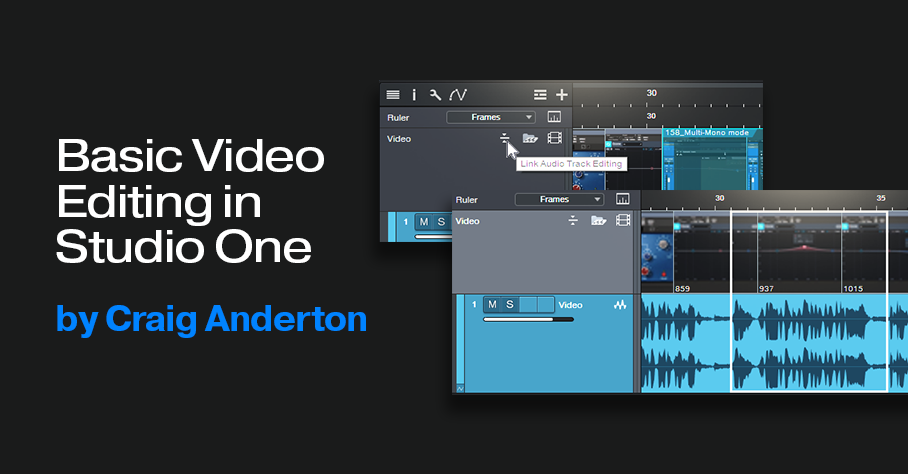
Studio One 6’s enhanced video track now includes basic editing. Yes! You can cut out the section of your band’s live video where the drunk guy came up and started singing along. Instead, just go directly to the part after the drunk was kicked out, and you re-started the song from the beginning.
You’ve likely heard the expression about something being “left on the cutting room floor.” Cutting out sections quickly and precisely is a crucial part of video editing. This requires being able to “jog” the cursor to locate the exact spot you want to split the video, down to individual frames (or even milliseconds). After the cursor is in place, then you can type Alt+X/Opt+X to split at the cursor.
For example, suppose I want to cut the section outlined in white in fig. 1. This is from a video I did on how to create a Pro Tools-like Multi-Mono plug-in mode in Studio One.
Choose the jog calibration you want to use. For precise cursor positioning, use frames or seconds (fig. 2).
If you chose frames, click in the transport’s frames field. Now, every mouse scroll click will jog the cursor forward or backward by one frame. In fig. 3, the cursor has been positioned exactly as desired. After being positioned, select the audio and video events that include the section to be split. Alt+X/Opt+X splits the audio and video events at the cursor position.
Of course, you don’t have to edit with single-frame resolution. For less critical edits, you can just place the cursor at the approximate position, and split.
Note: In a real-world situation, you’d have the video window open to confirm that the video is in the right location, and you’d probably zoom much closer in to make sure the cursor is at the exact split point. However, I wanted the screenshots to accommodate those reading this blog post on a smartphone 😊
Split at the end of the section you want to cut, and then select the video and audio sections to be cut (fig. 4).
Select Ripple editing (fig. 5). Ripple editing moves the video after the removed section earlier on the timeline, so it starts where the removed section started. This closes up the “hole” left by a cut section.
Delete the section you wanted to remove, and now the video closes up so that there’s no gap (fig. 6).
A Couple Other Tips
- Splits must be separated by at least one second. So, don’t expect to use splits to edit out a single cough or breath inhale. That needs to be done in a video editor, prior to working on the audio in Studio One.
- You can link or unlink audio track editing from the video (fig. 7). In this example, we wanted them linked. But suppose you did some time-stretching to the audio track. You might want to split it at a different place than where you would split the video.
To move around the video, click and drag on the mini-timeline in the video window (fig. 8).
Super-Simple Dim Solo Functionality
Dim solo is a variation on the standard solo function. With dim solo, non-soloed tracks are still audible, but at a lower level than any soloed track or tracks. This is great for many applications, including comping. Often, when auditioning comps, you want to hear them in context with the mix, but with the mix at a lower level. Dim solo is also helpful when checking out a track’s processing in isolation, or listening to a pair of tracks (like bass and drums) in context with the mix.
Studio One’s Listen bus offers a comprehensive dim solo function, but this tip is about a fast, easy way to add dim solo functionality, without needing the listen bus—or even having to actually solo tracks.
1. Select all the tracks in your project (e.g., click on the first track and shift+click on the last one).
2. De-select the track(s) you want to solo. You also need to de-select any channels that are already assigned to a VCA Channel. However, the VCA Channel that controls them should remain selected, so it can be dimmed along with the other tracks.
3. Choose Track > Add VCA for Selected Channels, or right-click on one of the selected tracks to add a VCA Channel for the selected channels (fig. 1).

4. All the selected tracks now show VCA1 under their faders (or a different number if there are already VCA Channels in the project), to confirm that their gain is being controlled by the VCA Channel. When first added, the VCA Channel’s initial level will be 0.0.
5. Now, vary the VCA Channel level to set the dimmed level for the selected tracks. The level for the unselected track (or tracks) will stay the same. Turning the VCA Channel all the way down provides the traditional solo function that mutes, rather than dims, the other tracks.

6. Do your edits on the soloed track(s). When you’re done, ctrl+click on the VCA Channel’s fader to return the VCA Channel to its initial value (0.0). After that, the levels of all the selected tracks and buses will return to what they were prior to step 1.
Once you use dim solo functionality, you’ll wonder how you got along without it.
Bonus Solo Tips
- For an Exclusive Solo function that solos one track while muting all others, click on Solo while holding Alt (Windows)/Option (Mac).
- If several tracks are soloed, to unsolo them all at once, hold Cmd/Ctrl while clicking on one of the solo buttons. To restore the same state, click on any Solo button while holding Cmd/Ctrl, and Studio One will revert to the previous solo button state.
Errata (fancy author word for “I messed up”): In The Huge Book of Studio One tips and Tricks, version 1.3, Chapter 2, page 181, fig. 2.77, the right-most panpot of the Dual Panpot should pan fully to the right, not to center. This is corrected in version 1.4, which is being updated for Studio One version 6. The update will be free to owners of any previous version of the book. Estimated publication date is early 1st quarter, 2023.
Metal Guitar Attack Pro
In June 2021, the blog post Metal Guitar Attack! described how to create a big sound for guitar power chords using Studio One Artist. Since then, I’ve ended up using this technique quite a bit. So, I wanted a version for Studio One Pro with an FX Chain that could fit in a single track, have a Macro Controls panel, and include some quick tone switches. Fig. 1 shows the FX Chain signal flow, which you can download at the end of this post. (Note that you need the High Intensity Pack for this tip.)
First of all, set the guitar channel’s mode to stereo, even if you recorded the guitar in mono. The Splitter will turn the mono into stereo anyway, which is necessary for the various Dual Pan modules. I also recommend using the neck pickup and rolling down your tone control, but see what works best for you.
The Splitter splits into three Ampires. In this FX Chain, all three use the default MCM 800 amp and 4×12 M65 cab. Feel free to substitute whatever amp/cab you want, but note that the Macro Controls for Dynamics on/off, Comp/Limit, OD on, Reverb On, Reverb Mix, and Preamp Gain all tie in to the main Ampire in Split 2. You’ll need to re-assign the macros if you substitute different stomp boxes. However, if you leave the stomp boxes in place, you can change the cab without altering the macro controls. For the amp itself, you’ll need only to re-connect the macro’s Preamp Gain control to the new amp’s preamp gain.
Split 1 goes to an Ampire with two pre-amp effects. The first is a 10-band EQ to condition the audio going into a Pitch Shifter, which transposes the audio -12 semitones. Split 3 goes to an identical setup, except that the EQ settings are different, and the Pitch Shifter transposes +12 semitones. All three splits then go to Dual Pans, so you can place the splits anywhere in the stereo field. The Pro EQ at the chain’s end connects to four Macro switches for Bass Cut, Bass Boost, Scoop, and Bright.
Speaking of the Macro Controls, fig. 2 shows how they’re laid out.

Because this FX Chain uses three Ampires and two Pitch Shifters, it eats up a lot of processing power. You’ll probably want to Transform to Rendered Audio after nailing your settings. (By the way, someone commented in a previous tip that transforming Ampire to save CPU doesn’t work, because it doesn’t return to your settings if you later decide it needs editing. This is not true! As long as you remember to check “Preserve Realtime State,” you can transform and return to real-time audio as many times as you want.)
Panning
The same tips apply here as in the June 2021 blog post. We’ll close out with an audio example that has panning set for the biggest sound—standard pitch full left, +12 center, -12 full right. The first half is chords, the second half is more single-note oriented. Remember, this is only one guitar—no overdubs
download Metal Guitar Attack Pro.multipreset
Deconstructed Guitar—a New Approach to Tone
Maybe you’ve seen food done as a deconstructed dish, where ingredients typically put together are served separately. For example, a deconstructed spring roll would plate all the ingredients inside it separately, with a dipping sauce on the side. You could wrap up the ingredients in whatever way you liked to construct your spring roll.
Wait—what does this have to do with guitar? Well, I had an opportunity to talk with Chris Jenkins, who won an Academy Award for the sound in “Mad Max – Fury Road” and worked on the documentary “The Beatles: Eight Days A Week — The Touring Years.” He mentioned how for the surround mix of ancient Beatles concert footage, instead of upmixing, they deconstructed it by sending pre-equalized sound into special-purpose, acoustical spaces optimized for different instruments. Re-recording the ”acoustified” sounds created the 5.1 mix. This is why footage from the 60s could sound natural and organic in 5.1 surround.
Sound effects sometimes use a related approach. If they don’t sound right laid into a film’s soundtrack, they’re sometimes played back in an acoustic space, re-recorded, and then added to the film. This makes them sound more “real world.”
So…what if you took a dry guitar sound, pre-equalized the sound, split it into stereo, and fed it into two virtual cabinets from Ampire (no amps, no effects) for a deconstructed guitar sound? Listen to the audio example, and judge for yourself. Audio Example 1 is direct-injected, dry Tele.
Audio Example 2 is also DI Tele, but split into two cabs. Note how the deconstructed guitar opens up space in the center, and no longer has that flat “DI sound.” What’s more, every time you change one of the cabs, you end up with a totally different tone. This approach is also ideal for LCR mixes, and the stereo image collapses well to mono.
Let’s look at how to set this up in Artist, and then how to make an FX Chain in Professional (go to the end to download the FX Chain).
Artist Setup
Fig. 1 shows the setup for Artist. The dry guitar track’s Pro EQ3 pre-conditions the sound going into the cabs. This is done to taste; there’s no specific “desirable” curve. Just create a curve that sounds good with the cabs you use.
Each of the dry guitar track’s pre-fader sends goes to a bus. Each bus has an Ampire inserted, but with no amp or effects—only a cab. One bus has a 1×12 American cab, while the other has a 4×12 American cab. But there’s nothing magic about those particular cabs, they just gave a sound I liked. In developing this tip, I tried a lot of cab combinations, and there were plenty of great-sounding options. Pre-conditioning with the EQ extended the options even further. For example, if a cab emphasized the bass too much, just trim the EQ’s low frequencies.
The Bus panpots are set to the Dual Pan option. That gives more imaging choices, although in the screen shot, they’re panned oppositely (hard left and hard right). To bring up the center, mix in some of the dry guitar track.
Pro Version FX Chain
With the Pro version, all this can fit into an FX Chain (fig. 2).
The Splitter uses Normal mode. The comments above about the Pro EQ3 and Ampires apply here. The Dual Pans are set to pan hard left for one cab and hard right for the other one, but you can use these plug-ins to “weight” the sound more to one side or the other. For example, in one Dual Pan, the left panpot could go could full left, and the right panpot to center. The other Dual Pan could pan the left panpot to center, and the right panpot hard right.
The Chorus at the end is just an extra little goodie. The .multipreset has it turned off, but feel free to enable it. So, simply download the .multipreset, insert it in your dry guitar track of choice…and have fun with deconstructing your guitar.
De-Esser Meets Amp Sims
Some guitarists feel amp sims don’t sound “warm” or “smooth,” but that can also be an issue with physical amps. This is why guitar players often turn down a guitar’s tone control to reduce highs. Distortion adds harmonics, so distorting highs just piles on more highs.
Single-coil pickups have a naturally brighter sound than humbuckers, so they tend to highlight potential high-frequency issues. One fix is a narrow, sharp cut at a specific frequency to sweeten the sound, as described in The Ampire Sweetener. However, now that version 6 has a De-Esser, we can use its dynamic response for “intelligent” sweetening.
How the De-Esser Works
A de-esser reduces excessive vocal sibilants (“s” sounds) by compressing only high frequencies. This lowers the sibilants’ level, while leaving the rest of the vocal relatively untouched.
Although the EQ3’s dynamic EQ can produce this effect, for guitar the De-Esser is more plug-and-play. The controls that narrow in on “ess” sounds make it easy to narrow in on the guitar sounds you want to tame.
How to Set the Controls
The de-esser can go either before or after an amp sim. Placing the de-esser after the sim can clean up the highs that the sim generates, but pre-amp sim placement lets you suppress high frequencies before they’re distorted (fig. 1). Try both options—the effect is quite different.
To zero in on the best pre-amp sim De-Esser settings:
1. Loop your guitar, and listen to the amp sim output.
2. Set Range = Full, Shape = Narrow, and S-Reduction to 0.00.
3. Enable Listen, and vary the Frequency control. The sound will be nasty, because you’re trying to highlight where an amp sim performs at its worst. Find the most objectionable-sounding frequency, which will likely be around 4 to 7 kHz.
4. Turn off Listen, and turn S-Reduction counter-clockwise to reduce the highs feeding the amp.
In the audio example, the first part doesn’t have the De-Esser inserted. The second part does. Remember that the De-Esser functions dynamically, so the effect will be most obvious on the loudest chords. In this example, compare the last two measures of each part. You’ll hear how the de-esser in the second part removes that slight high-frequency “edge.”
Post-Amp Sim De-Essing
When inserted after the amp sim, the De-Esser becomes more of an effect that can modify the amp sim sound. I’d recommend the following to become familiar with this effect:
1. Loop your guitar, and listen to the amp sim output.
2. Start with Range = Full, Shape = Narrow, and S-Reduction at -60.00.
3. Use the Frequency control to dial in the high-frequency range you want to reduce.
4. Vary the S-Reduction control for the amount of attenuation.
For more of a humbucker character with single-coil pickups, choose Wide instead of Narrow. Wide splits the audio into two bands, and reduces levels above the Frequency setting. Narrow splits the audio into three bands, and reduces levels in the middle band. Then, vary the Frequency control. The optimum setting will likely be at 6 kHz and below (fig. 2). Again, choose the amount of high-frequency attenuation with the S-Reduction control.
Final Thoughts
Whether to insert the De-Esser pre- or post-amp sim depends on the amp sim. The audio example uses Ampire, which is one of the better amp sims. Inserting the De-Esser before the amp is really all that’s needed. Sims with “nastier” high frequencies benefit more from post-amp placement, because the De-Esser can give a more drastic effect.
In any case, the above suggested settings are starting points. The best approach is to loop your guitar, enable your amp sim, and play with the controls. You might be surprised at how the De-Esser can add the extra touch that’s needed to turn an amp sim from good to great.
